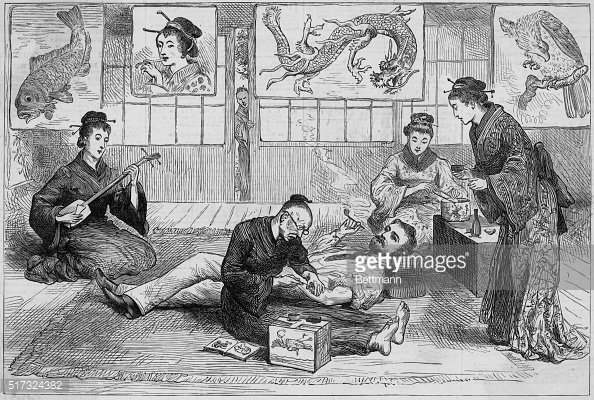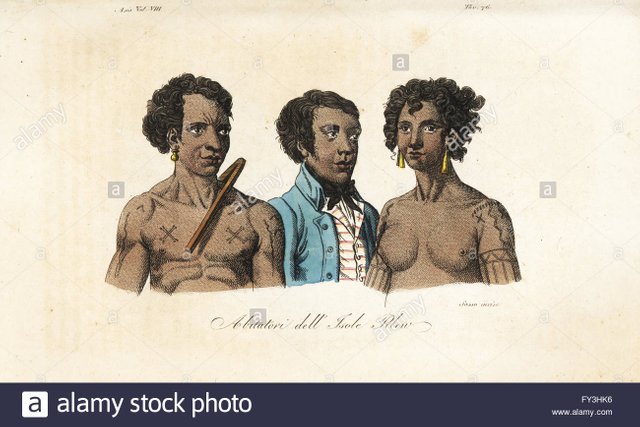History of Tattoos and Social Status Symbol
History of tattoos and social status symbol in Britain into a long story relates to another country, from Rome, Japan, to American and Pacific Islanders.
If the tattoo in other areas often synonymous with the tradition of thugs, not in England. In fact, the tattoo in England had become a symbol of social status, thus becoming a widespread trend. History of tattoos and social status in the UK appear so thick in the 19th century.

There are no tattoos on his face. But the tattoo on his arm when he publicly visible by an audience with the Emperor Meiji. Since then, tattoos are becoming increasingly trend in the UK.

A picture of the Europeans tattooed on Nagasaki, Japan.
Meiji Restoration in 1868 indeed has opened political and trade relations with the outside, including the UK. Many more European aristocrats and often to Japan. And, they return on average bring souvenirs in the form of tattoos on his body.
Especially after the Prince George tattooed, wider trend. Tattoo industry in the UK is also more widespread. Tattoos became a symbol of social status."Tattooing the future king became famous until the moment what's imaginative pictures as a souvenir for the marriage of George in 1893," said Matt Lodder, professor of contemporary art at the University of Essex."So, everyone knows that if you are rich and go to Japan, it will return to the body berato," he continued.
Although George became a trendsetter in the era of tattoos and tattoo image building social status, but the tattoo tradition in the UK or Europe has long been underway. In the era of Emperor Julis Caesar, people would have also helped popularize tattoos.
The first evidence of human tattooed in history was 5000 years ago were found on the mummy Otzi the Ice Man. Jenaahnya found in the Alps between Italy and Austria."But, in Europe, the Englishman who popularized, ketia Romans invaded Britain in 55 BC. As written Julio Caesar in the Gallic Wars." It (the tattoo) to make them known in Europe as Pretani, the term Celtic meaning people who display or tattooed. Since then, the origin of the name of Britain appear. "
Indeed, there are many opinions that the English at that time only to draw his body, not tattooed. However, scholars Roma then confirm that what he saw Caesar is the ink on the body."The region was ruled by the barbarian who since childhood have pictures of different animals and skillfully implanted in their bodies. Thus, as a grown man, a sign that will grow with him," wrote Julius Solinus Galus in the 3rd century.
"When the Norman came to England in 1066, they also found that Britons tattooed smart. In the 12th century, William of Malmesbury described how a tattoo is one of the Norman adopted practices of indigenous peoples."
But, the modern history of tattoos in England developed in the colonial period and was adopted from America. An explorer, Martin Frobisher, made a number of expeditions to the New World between 1576-1578. She found a tattoo a tradition in Native American communities.In 1577, Frobisher brought 3 hostages of Inuit traveling to the UK from Bristol to London to show their tattoo art. In fact, he had performed in the presence of Queen Elizabeth. Public art awe of their tattoos.

However, the word tattoo (Tattoo) itself known during Captain James Cook who venture to the Pacific Islands in the 18th century. Even so, the term tattoo already exist in the English language in the late 1600s in terms of hitting the tattoo (beating a tattoo, referring to the drum.In 1769, Cook exploring Tahiti. That area has a tradition of tattooing. Tahitians called it with the word "tatau" to refer to the use of a hammer and a needle arranged like a comb to tattooed body.
In his diary, Cook wrote tattoo to explain the art of drawing the body and demonstrated to many people. Since then, the term tattoo (tattoo) entered in English.Besides mempuperkan tattoos, the British also began to commercialize the art of tattooing in the western world.
Tato gets bigger in 1854, when an aristocrat Roger Tichborne was lost at sea. But, 12 years later she suddenly appeared in Austalia and then sailed to London. Unwelcome presence of his brothers. When his mother died, he was entitled to the inheritance. This is an issue to court.
The court must membuktikandia is Tichborne thus entitled to the inheritance of the mother. There is evidence that as a child by his tattooed Tichborne. So, he asked the court to show it. It turned out that he could not and eventually proved false Tichborne. He turned out to Arthur Orton, the son of a butcher. He was sentenced to 14 years in prison.
Thus, the tattoo becomes a big issue. Even then the idea should children since childhood tattooed as a sign. Thus, if in the future there is a problem, it is easy to prove.
Nice history news! Good post..
Great article. Very interesting history perspective